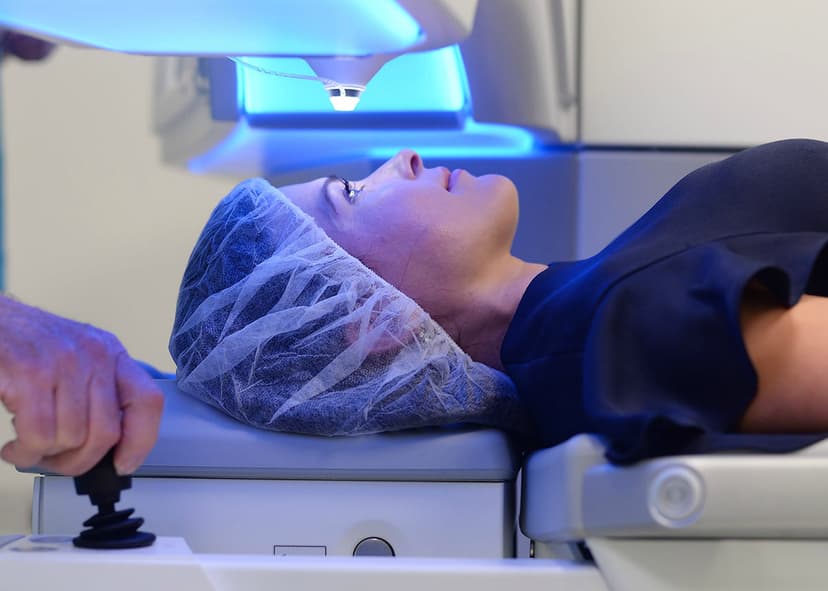
Understanding The Safety Of Laser Eye Surgery
In the ever-advancing field of ophthalmology, laser eye surgery has emerged as a transformative and widely embraced solution for vision correction. At the forefront of patient concerns when considering such a procedure is the paramount issue of safety. Laser eye surgery, including techniques such as LASIK (Laser-Assisted In Situ Keratomileusis) and PRK (Photorefractive Keratectomy), is designed with a primary focus on patient well-being and safety. Rigorous screening processes, state-of-the-art technology, and highly trained surgeons collectively contribute to minimising risks and ensuring optimal outcomes. As we delve into the realm of laser eye surgery safety, it becomes evident that the field has not only evolved technologically but has also prioritised comprehensive safety protocols to provide patients with confidence and peace of mind throughout their vision correction journey.
Navigating the landscape of laser eye surgery safety involves understanding the meticulous measures taken to mitigate potential risks. From the initial consultation, where a thorough examination assesses the patient's suitability for the procedure, to the precise laser technology employed during surgery, every step is orchestrated to prioritise the patient's safety. Surgeons, equipped with years of specialised training, adhere to strict protocols to minimise complications and enhance the overall safety profile of laser eye surgery. This dual commitment to technological advancement and stringent safety standards underscores laser eye surgery as a reliable and increasingly routine procedure, offering individuals the prospect of improved vision with a high degree of confidence in its safety.
Patient Screening and Consultation
Patient screening and consultation play a pivotal role in the safety and success of laser eye surgery, serving as the initial checkpoint to determine a patient's candidacy for the procedure. The importance of this phase cannot be overstated, as it allows healthcare professionals to assess the patient's overall health, eye conditions, and lifestyle factors that may influence the outcome of the surgery. Thorough screening helps identify potential risks, contraindications, or pre-existing conditions that could impact the safety of the procedure. This comprehensive evaluation ensures that only individuals with suitable ocular and general health profiles proceed to the next stages of laser eye surgery, contributing significantly to minimising potential complications and optimising the overall safety of the process.
The process of patient screening and consultation involves several key steps to gather pertinent information and make informed decisions. Typically, this begins with a detailed medical history review, where patients disclose any pre-existing eye conditions, general health issues, or medications they may be taking. Ocular examinations, including measurements of visual acuity, refractive errors, and corneal thickness, follow suit. Diagnostic tests, such as corneal topography and wavefront analysis, contribute additional data crucial for personalised treatment planning. In the consultation phase, healthcare professionals engage in open communication with patients, addressing their concerns, explaining the intricacies of the procedure, and ensuring that expectations align with realistic outcomes. This collaborative approach not only enhances the safety of laser eye surgery but also establishes a foundation of trust and transparency between the healthcare provider and the patient.

The Surgical Process
Embarking on the journey of laser eye surgery involves a meticulously orchestrated sequence of steps, each designed to prioritise patient safety and optimise visual outcomes.
Step-by-Step Guide
1. Anaesthetic Application
The procedure commences with the application of numbing eye drops to ensure patient comfort throughout. This step is crucial not only for pain management but also to minimise any discomfort during the surgery.
2. Flap Creation (LASIK)
In LASIK surgery, a microkeratome or femtosecond laser is employed to create a thin flap on the cornea. This initial step allows access to the underlying tissue for reshaping.
3. Tissue Reshaping
The next stage involves the precise reshaping of the cornea using an excimer laser. This step is pivotal for correcting refractive errors such as nearsightedness, farsightedness, and astigmatism.
4. Flap Re-positioning (LASIK)
For LASIK patients, once the corneal reshaping is complete, the flap is delicately repositioned. This natural bandage promotes rapid healing and reduces the risk of infection.
5. Surface Ablation (PRK)
In PRK surgery, instead of creating a flap, the outer layer of the cornea (epithelium) is gently removed before the reshaping process. The epithelium regenerates naturally in the days following the surgery.
6. Laser Precision
Throughout both LASIK and PRK procedures, advanced laser technology ensures an unparalleled level of precision. This precision is instrumental in achieving the desired correction while minimising impact on surrounding tissues.
7. Postoperative Care
Following the reshaping process, a protective shield or bandage contact lens may be applied to aid in the initial healing phase. Patients are provided with detailed postoperative care instructions to optimise recovery.
Technology Utilisation
Laser eye surgery harnesses cutting-edge technologies to enhance precision, improve safety, and refine visual outcomes. The excimer laser, a cornerstone of these procedures, uses ultraviolet light to precisely remove microscopic amounts of corneal tissue, allowing for meticulous reshaping. Additionally, advanced diagnostic technologies like corneal topography and wavefront analysis contribute to personalised treatment plans by mapping the unique contours of each patient's eye.
In LASIK, femtosecond lasers are often used for flap creation, offering a higher degree of precision compared to traditional microkeratomes. These lasers operate at incredibly short time intervals, allowing for a more controlled and customisable corneal flap.
Beyond laser technologies, eye-tracking systems are incorporated to account for any subtle eye movements during the procedure, ensuring accurate delivery of laser pulses. This level of technological sophistication collectively contributes to a safer surgical experience by minimising the margin of error and optimising the predictability of visual outcomes.

Surgeon Expertise and Training
The proficiency and qualifications of surgeons undertaking laser eye surgery are paramount factors influencing the safety and success of these procedures. Surgeons specialising in refractive surgery, particularly LASIK and PRK, undergo extensive education and training to hone their skills and acquire a nuanced understanding of ocular anatomy and physiology. Typically, a reputable surgeon in this field holds a medical degree, followed by specialised training in ophthalmology. Board certification by relevant medical authorities signifies a commitment to meeting the highest standards of competency and ethical practice.
Qualifications
The qualifications of a laser eye surgeon are a testament to their educational background, professional development, and adherence to stringent standards. Many surgeons specialising in refractive surgery are members of esteemed professional organisations dedicated to advancing the field of ophthalmology. These organisations often set guidelines for ethical conduct, ongoing education, and continuous improvement, ensuring that their members remain at the forefront of advancements in laser eye surgery techniques and safety protocols.
Safety Assurance
The safety of laser eye surgery is inherently linked to the experience and training of the performing surgeon. Surgeons with extensive experience in refractive surgery have encountered a wide range of cases, allowing them to develop a comprehensive understanding of potential challenges and how to navigate them effectively. Their seasoned expertise instils confidence in patients, as they can trust that their surgeon has successfully managed various scenarios, prioritising safety without compromising the precision and efficacy of the procedure.
Moreover, ongoing professional development is crucial for laser eye surgeons to stay abreast of emerging technologies, refined surgical techniques, and evolving safety standards. Continuous education ensures that surgeons integrate the latest advancements into their practice, further enhancing the safety and overall quality of laser eye surgery. Patients can find reassurance in the hands of surgeons who not only meet the necessary qualifications but also demonstrate a commitment to lifelong learning and the pursuit of excellence in the field of refractive surgery.

Sterility and Hygiene
Sterility and hygiene are paramount in the context of laser eye surgery, ensuring a sterile environment that minimises the risk of infections and complications. Surgical instruments, equipment, and the entire operating room undergo rigorous sterilisation processes to maintain an aseptic environment. The surgical team adheres to stringent hygiene protocols, including the use of sterile gowns, gloves, and masks. This commitment to maintaining a sterile field is crucial during laser eye surgery, where any introduction of bacteria could potentially lead to postoperative complications. By upholding the highest standards of sterility and hygiene, laser eye surgery clinics prioritise patient safety and contribute to the overall success of the procedure, providing individuals with the confidence that their vision correction journey is conducted under the most sanitary conditions.
Emergency Preparedness
Emergency preparedness is a fundamental aspect of laser eye surgery clinics, ensuring a swift and effective response to any unforeseen complications that may arise during or after a procedure. These clinics are equipped with comprehensive emergency protocols, including the availability of emergency medications, resuscitation equipment, and immediate access to healthcare professionals trained in emergency response. The well-prepared surgical team undergoes regular training exercises to enhance their ability to handle unexpected situations, demonstrating a commitment to patient safety. Whether addressing rare adverse reactions or unforeseen issues, the emphasis on emergency preparedness underscores the clinic's dedication to providing a secure environment for patients undergoing laser eye surgery, contributing to an overall sense of reassurance throughout the surgical process.
Postoperative Care and Monitoring
After the completion of laser eye surgery, a crucial phase begins—postoperative care and monitoring. Patients receive detailed instructions to guide them through the initial recovery period. This often includes the application of prescribed eye drops to aid healing and prevent infection. A protective shield or bandage contact lens may be utilised to safeguard the cornea during the early stages of healing.
Regular follow-up appointments are an integral component of postoperative care, allowing surgeons to closely monitor the healing process and address any potential concerns promptly. These appointments typically involve comprehensive eye examinations to assess visual acuity, eye pressure, and overall ocular health. The surgeon evaluates the success of the procedure, ensuring that the desired correction has been achieved.
Patients are encouraged to adhere strictly to the provided postoperative care instructions, which may include temporary restrictions on activities such as swimming or strenuous exercise. These measures are implemented to support optimal healing and minimise the risk of complications.
The postoperative care and monitoring phase is not only about physical healing but also addressing any questions or concerns that may arise. Open communication between the patient and the surgical team during this period is key to a successful recovery, ensuring that patients feel supported and well-informed as they embark on their journey towards clearer vision.

Our Top 5 Laser Eye Surgery Stats
99% Success Rate
A recent LASIK report from the American Refractive Surgery Council, LASIK's success rate has surpassed 99% This remarkable statistic underscores the significant advancements in technology over the years, highlighting the impressive outcomes achievable through LASIK procedures.
100,000 UK customers per year
More than 100,000 laser eye surgery procedures are carried out every single year in the UK alone.
You won’t go blind
The LASIK procedure, in its essence, does not lead to blindness. Many complications associated with LASIK surgeries are frequently avoidable, underscoring the importance of adhering to the appropriate postoperative care guidelines. Your surgeon will provide specific aftercare instructions, including a list of potential complications to monitor. Promptly addressing any identified issues is generally effective in preventing the escalation of problems after laser eye surgery.
A global phenomenon
Laser eye surgery treats 30 million people every year on a global scale.
20/20 vision
The American Refractive Surgery Council has announced that 90% of people who undergo LASIK surgery end up with vision that is 20/20 or better. This number is set to increase as time goes on and as technology develops even further.
Put Your Trust Into My-iClinic
Experience the pinnacle of safety and cutting-edge technology at My-iClinic, where your vision is our top priority. Our dedicated team of highly skilled eye surgeons, boasting years of expertise in the field, is committed to delivering the highest standard of care. We leverage the most advanced technologies in the industry to ensure precision, effectiveness, and peace of mind. Don't compromise on your vision – trust My-iClinic for a safe, state-of-the-art, and personalised eye care experience. Schedule your consultation today and embark on a journey to unparalleled visual clarity.
Find out more by Speaking to our team









